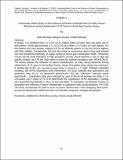Community-Based Study on the Influence of Parent Characteristics on Risky Sexual Behaviours among Adolescents 15-19 Years in Homa-Bay County, Kenya
Publication Date
2021-09-09Type
Book chapterviews
downloads
Metadata
Show full item record
Abstract/
Abstract Health facility factors have been highly associated with the uptake of health servicer not only among adolescents but also to the general population at large. Nevertheless, because of special sexual and reproductive needs of the adolescents, these facility characteristics exacerbate it. Homa-Bay county is ranked high in early child motherhood, it account for 178 per 1000 adolescents’ 15-19 years age specific fertility rate nearly twice the national level of 96 per 1000. Furthermore, Homa Bay County’s child marriage is at 47.4% this figure is more than twice the national prevalence of 23%. There is high unmet need for contraceptives prevalence among adolescent 15-19 years at 62 %; this is three times the national prevalence of 23%. Consequentially, the County has the highest prevalence of HIV/AIDS, at 26 %; this is four times higher than the national prevalence of 6%. Given these poor indicators the study hypothesized that health facility characteristics could be the weaker link. The study endeavored to assess health facility characteristics influencing the uptake of reproductive health services among adolescent 15-19 years in Homa Bay County, Kenya. Descriptive study design was used. Stratified sampling of all the wards in Homa-bay sub-county was conducted. Systematic sampling was carried out in all the households with eligible participants. A sample size of 325 was determined by use of Fishers formula n = z 2 pq/d2 . A total of 306 (94%) participants were interviewed. Both quantitative and qualitative data were collected. Interviewer led structured questionnaire was carried out to collect quantitative data. Key informant interview guide was employed to collect qualitative data. The participants and the key informant gave self reported data. However, the study did not perceive any limitation since the topic was not very sensitive. Quantitative data was analyzed using Ms-excel package and Stata V 14. Chi-square and p-value of ≤0.05 determined significance at 95% confidence interval. The study recorded a strong association between health facility characteristics and uptake of adolescents reproductive health services, PV = 0.000, X 2 44.259, C.I. 0.247-3.19. Quantitative data was processed thematically and reported. Data was presented descriptively in bar, pie charts and graphs. Health facility characteristics have been found statistically significant in the uptake of sexual and reproductively health services by adolescents. There is need to encompass health facility characteristics when designing health promotion policies, programs and strategies of adolescents sexual and reproductive health.
Publisher
CEDRED PublicationsISBN
ISBN 978-9966-116-58-1Permalink
https://kenyasocialscienceforum.wordpress.com/2020/10/02/strategic-governance-and-sustainable-development-in-africa-maurice-n-amutabi-and-magdalene-ndeto/https://repository.amref.ac.ke/handle/20.500.14173/880
Collections
- Book Chapters [14]

